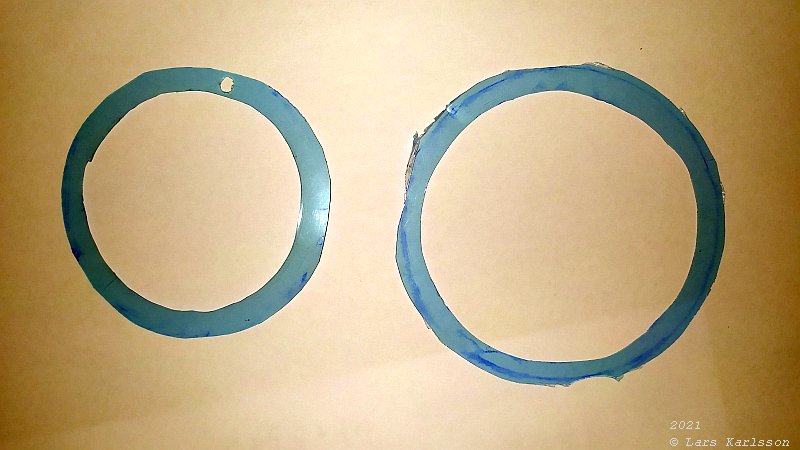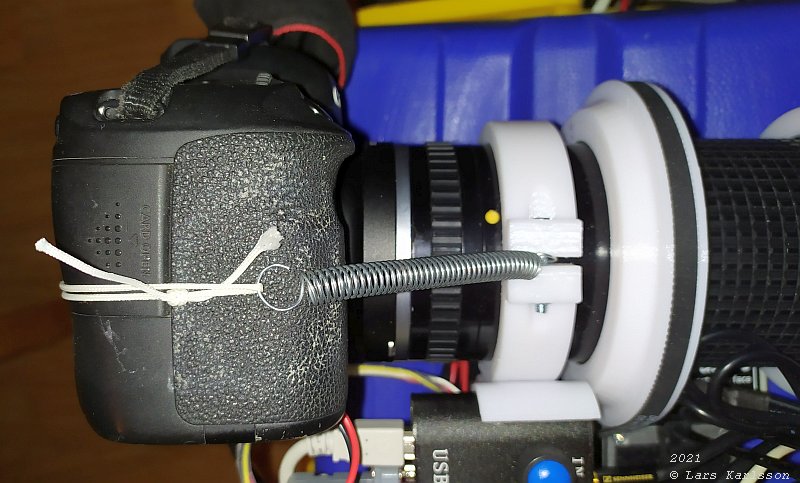|
Advertisement / Annons: |
Project:
|
Contents:
Related projects:
Note: |
4: Temperature compensating and tilted focus planeI have now taken some test astrophotos, it will come on the homepage later when they are good enough. I have also started to build a table of the temperature focus data and noticed elongated stars in one corner. Temperature compensating:
I use the APT software to control the USB-focuser over ASCOM. In the configuration tab I enable the temperature compensating. The value I got from the focus positions with variation of the temperature I collect in a data table. From that table I can calculate the temperature compensation parameter. With just a few values I got it to be -400 steps / degree Celsius. Later with more data I got it much lower. Tilted focus plane:
Sometimes I got elongated stars in the upper left corner, but not always. It looks that it arise from a tilted focus plane. This is the corner of a full frame sensor. Have a look at my analyze of the vignetting. 
Analyze one of the images with Astap and CCD inspector give this result. Higher values indicate out of focus. It indicate that the sensor is tilted (not orthogonal, 90 degree) relative the lens optical axis, but how much ? 
I examined the bayonet, found that the leaf springs into it to be too weak. The camera can hang and get tilted in some positions. I measure the connection between the camera and the bayonet, it's about 0.35 mm. Maybe I can made a soft plastic shim that hold it in place. After a more careful investigation I found three places where there is a small play, see the arrows in the photo above. Here how I try to solve this problem with the 3D-printer: Shim for Canon EOS bayonet. It failed. This wasn't easy to fix. When I couldn't 3D-print shims thin enough I took a plastic sheet and made new shims from it. 
My new shims, just some prototypes. If they work well I made better ones of brass later. But complicated to have the shims installed, every time I have to clean the camera sensor I must deal with these shims. I have installed one of the plastic shims above between the camera and the adapter, it's 0.17 mm thick, still some play. I tried with two shims, 0.35 mm but then it wasn't possible to get connect it together. Maybe 0.25 mm will fit perfect. When I examined the construction in more detail I also noticed a play between the lens and the adapter, made a new shim, 0.17 mm thick, but too thick, couldn't connect the bayonet it together. There is one place more with play, at the end of the lens. All this are normal and doesn't matter when doing normal photographing, but when doing astrophotographing when all objects are at infinity it's a big problem. The play cause the camera hang a little bit and then you get a tilted focus plane. It's the same problem on cheaper telescopes, a good focuser in 3" could cost 1000 Euro. On my telescope I have on the 2.5" focuser a tilt adapter that I can adjust. If I made the adapter to clamp around the lens I will not get any play more than the place where it connect to the camera, maybe I can made even that connection better. This will only be a temporary solution. Later I shall 3D-print my own adapter. I have 27 mm between the lens and camera with a Canon EOS DSLR camera, I can implement a filter drawer in that space. If I change to a Canon mirror less camera I will have 47 mm between the lens and camera, then maybe I can also fit an off-axis adapter into it. It will be complicated but that's why astronomy is so exiting ! How much work I will spend on this depend on how good images the lens deliver. The latest test image, M13. I think I can say it looks good if it hasn't been the elongated stars in one corner. 
I felt the above solution with shims to eliminate the play was wrong, too complicated for a temporary solution. Instead I installed a spring that act on a string that's wrapped around the camera. All three places where I had a play will now be set under force and eliminated. Easy to take away the camera when I need to clean it too. But does it work in reality ? Have a look at the photo of Nova V1405 Cas. Look at the stars in the corners.
|
|